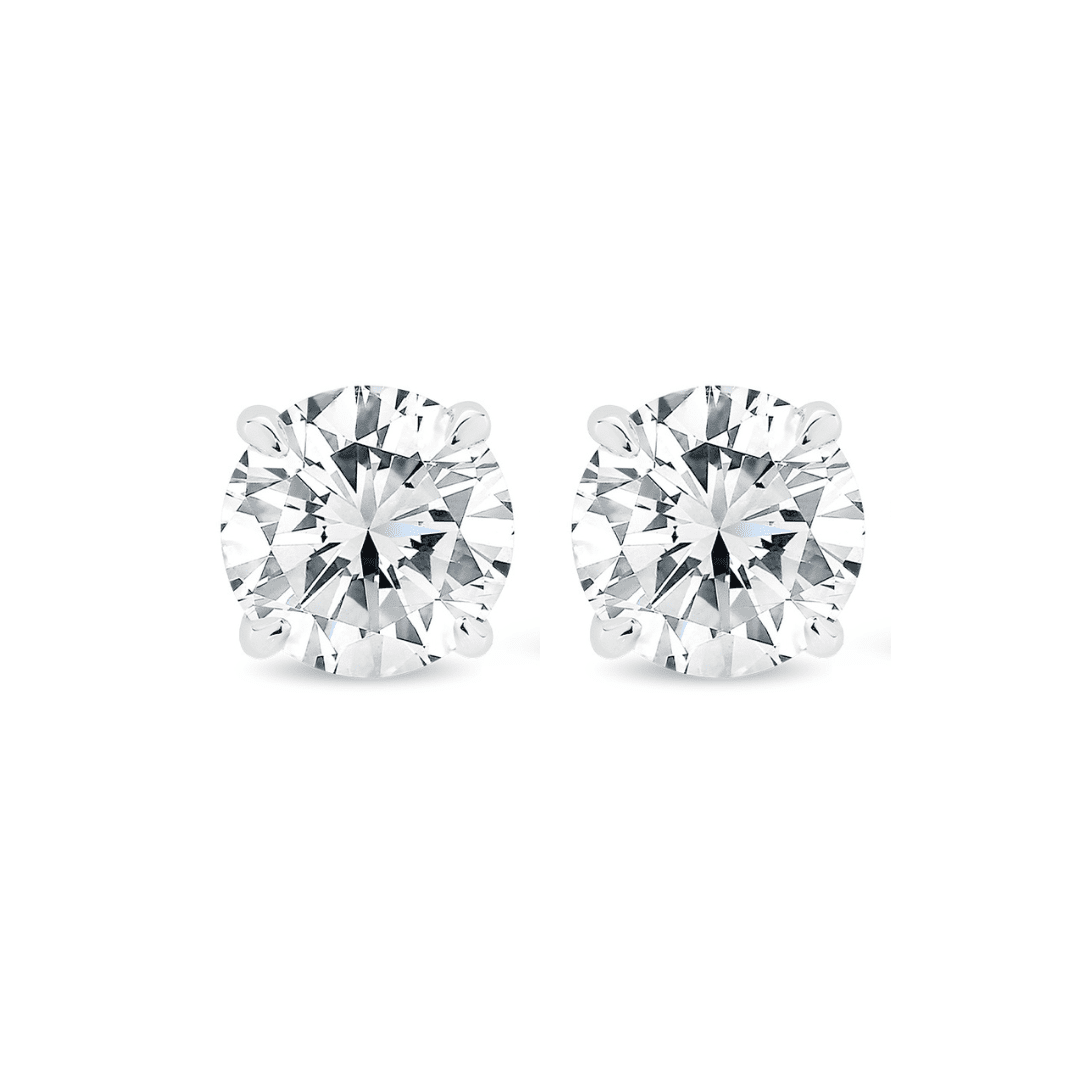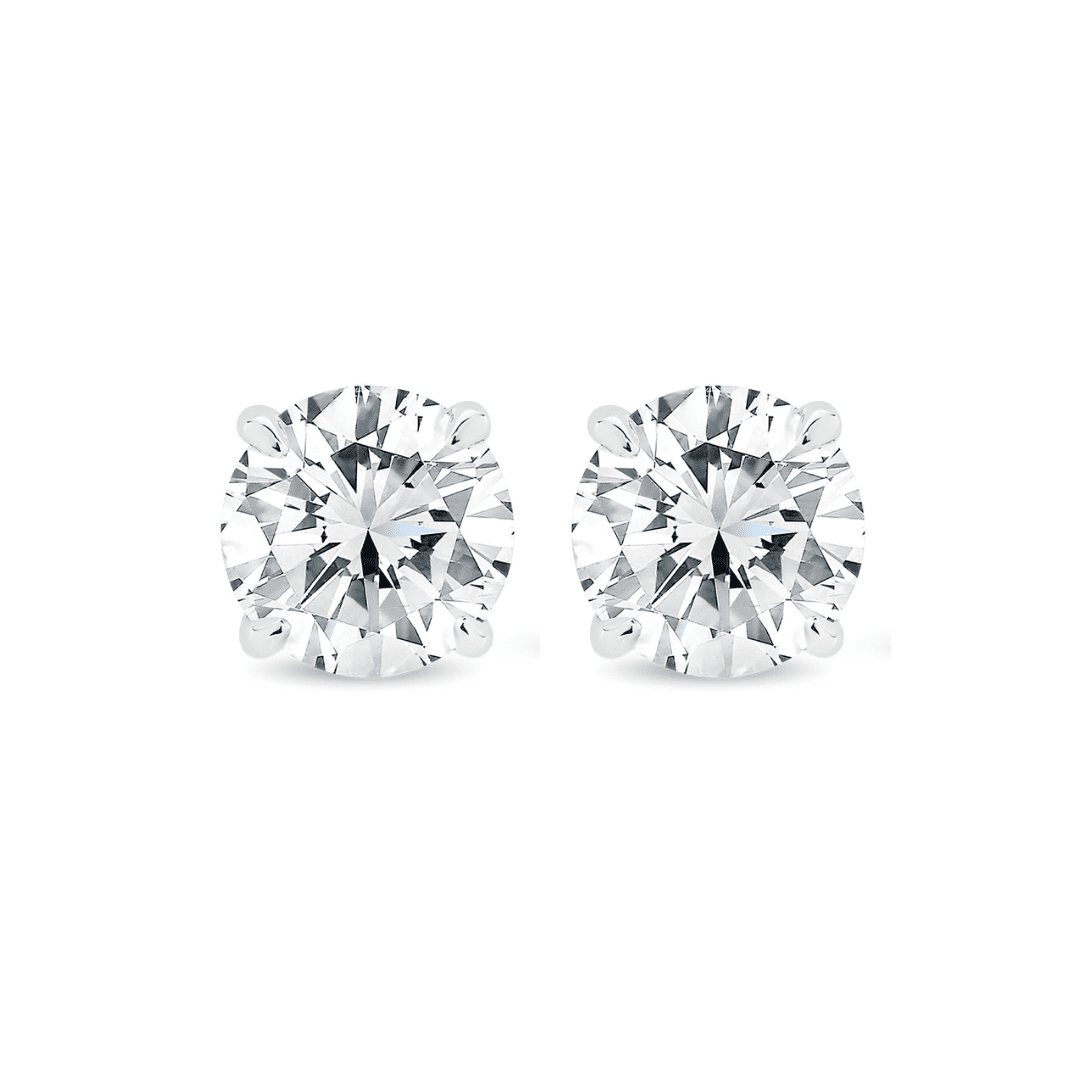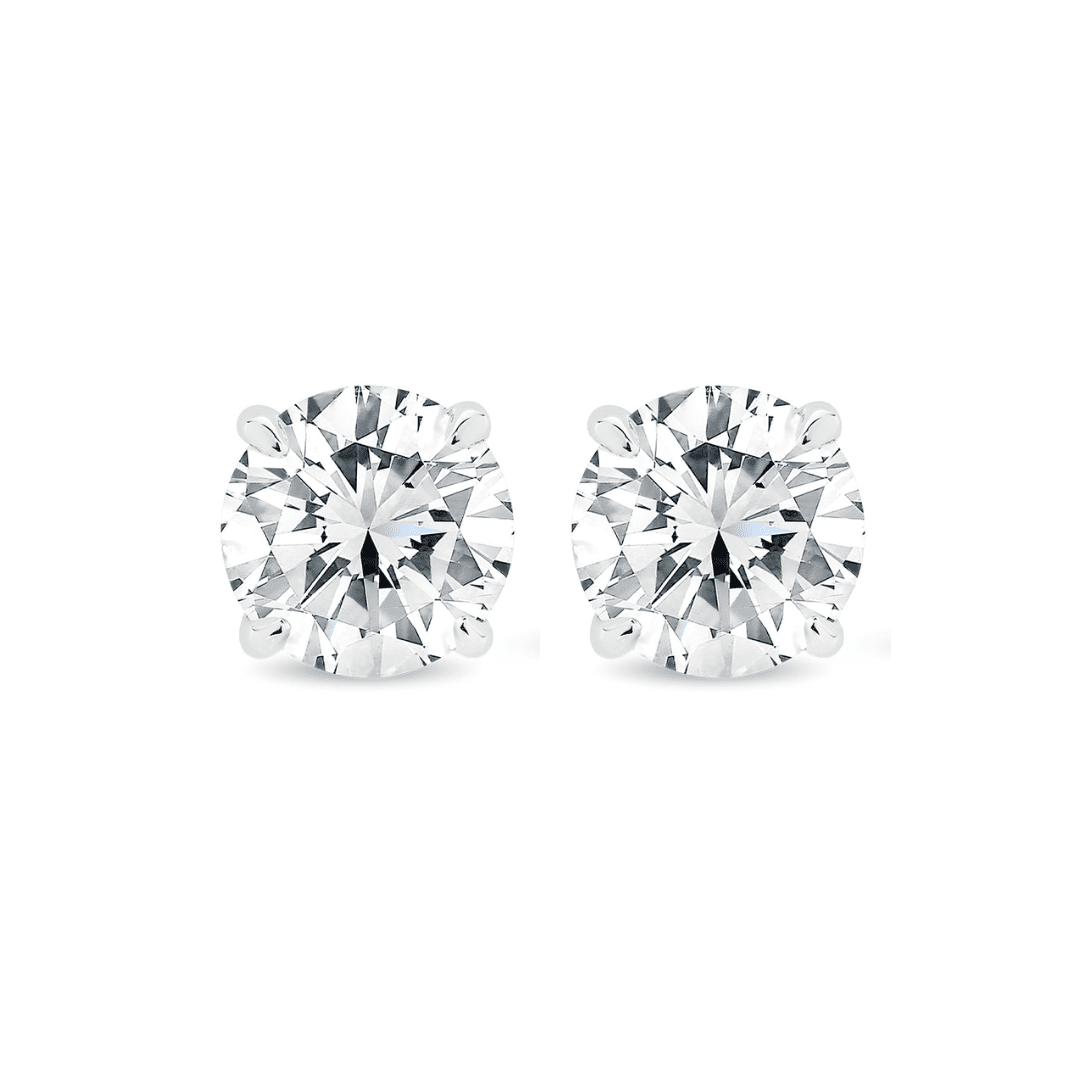
Lab diamond stud earrings represent the pinnacle of versatile sophistication. They offer the enduring sparkle of diamonds, the ethical assurance of sustainable creation, and the accessible luxury of modern technology – all condensed into a pair of earrings that transition seamlessly from boardroom brilliance to evening enchantment. Choosing the “best” pair is a personal journey, balancing quality, style, budget, and values. This comprehensive guide empowers you to navigate the world of lab-grown diamond studs with confidence, ensuring your investment delivers unparalleled beauty and peace of mind.
The Enduring Appeal of Diamond Studs: Why They Reign Supreme
Diamond stud earrings are arguably the most essential piece of jewelry one can own. Their universal appeal stems from undeniable strengths:
-
Unmatched Versatility: Effortlessly complementing any outfit, style, or occasion. They are equally at home with jeans and a t-shirt as they are with a formal gown. Their understated elegance never overwhelms, always enhances.
-
Timeless Elegance: Transcending fleeting fashion trends, diamond studs are a permanent fixture in the jewelry lexicon. They represent classic, sophisticated beauty that endures for generations.
-
Effortless Sophistication: They convey polish, confidence, and refined taste without saying a word. A well-chosen pair instantly elevates your look.
-
Comfort and Practicality: When set securely with appropriate backings, studs are comfortable for all-day, everyday wear. They don’t snag on clothing or hair, making them incredibly practical.
-
Symbolic Meaning: Often gifted to mark significant milestones – graduations, promotions, anniversaries, birthdays, or simply as a gesture of enduring love and appreciation. They become cherished heirlooms.
-
Focus on Pure Brilliance: Without elaborate settings or designs, the spotlight remains solely on the diamonds themselves – their fire, brilliance, and scintillation take center stage.
Why Lab Grown Diamonds are the Perfect Match for Studs:
The rise of lab-grown diamonds has revolutionized the stud earring market, offering compelling advantages perfectly aligned with the stud’s core virtues:
-
Exceptional Value: Lab-grown diamonds typically cost 30-70% less than their mined counterparts of identical quality. This allows you to:
-
Size Up: Purchase significantly larger carat total weight (cttw) studs for your budget.
-
Quality Up: Opt for higher color (near colorless) and clarity (eye-clean) grades within your budget.
-
Metal Upgrade: Choose premium settings like platinum without breaking the bank.
-
-
Guilt-Free Sparkle: Lab-grown diamonds are inherently conflict-free. Their creation bypasses the complex and often problematic ethical issues associated with some traditional diamond mining (e.g., human rights concerns, funding conflicts). You wear them with a clear conscience.
-
Sustainable Choice: While requiring energy, lab diamond production generally has a significantly lower environmental footprint than large-scale mining operations. It involves minimal land disruption, reduced water usage, and lower carbon emissions per carat, especially as manufacturers increasingly utilize renewable energy sources.
-
Consistent Quality & Availability: Labs can produce diamonds with specific, desirable characteristics (like high color and clarity) more reliably and abundantly than nature. Finding perfectly matched pairs for studs is easier and often results in superior symmetry and uniformity compared to sourcing two identical mined stones.
-
Identical Physical and Optical Properties: Scientifically, chemically, and optically, lab-grown diamonds are real diamonds. They possess the same hardness (10 on the Mohs scale), brilliance, fire, and scintillation. Even a professional jeweler cannot distinguish them from mined diamonds without specialized laboratory equipment. The difference is purely origin.
-
Modern Innovation: Choosing lab diamonds reflects an appreciation for technological advancement and responsible consumption, aligning with contemporary values.
Demystifying the “Best”: Key Factors in Choosing Your Perfect Lab Diamond Studs
Determining the “best” lab diamond studs hinges on understanding and prioritizing several critical factors:
-
The 4Cs Applied to Studs:
-
Carat Weight (Size):
-
Total Carat Weight (cttw): This is the combined weight of both diamonds in the pair (e.g., two 0.50ct diamonds = 1.00 cttw). This is the primary measure of size.
-
Individual Diamond Size: Studs are often described by the weight of each individual diamond (e.g., 0.50ct each). Be clear on whether a listing specifies cttw or per-stone weight.
-
Size Perception: Millimeter (mm) diameter is crucial. A well-cut 0.50ct round diamond is typically around 5.1-5.2mm. Compare mm sizes, especially if considering different shapes (e.g., a 0.50ct princess cut might be smaller in mm than a 0.50ct round). Consider what size is proportional and comfortable for your earlobe and personal style. Popular sizes range from subtle (0.25ct each / 0.50 cttw) to statement (1.00ct each / 2.00 cttw or larger).
-
-
Cut (The Source of Sparkle):
-
Crucial for Brilliance: While all 4Cs matter, cut quality is paramount for maximizing the diamond’s light performance – its brilliance (white light), fire (flashes of color), and scintillation (sparkle).
-
Grading: For round brilliant diamonds (the most popular stud shape), look for GIA or IGI cut grades of Excellent or Ideal. This ensures optimal proportions and symmetry. Very Good can also be an excellent value choice, especially for smaller stones where the difference is less noticeable. Avoid Good or below.
-
Fancy Shapes: For princess, cushion, oval, pear, emerald, asscher, etc., GIA doesn’t give a single cut grade. Prioritize diamonds with excellent symmetry and polish grades (Excellent or Very Good). Scrutinize high-resolution videos for consistent sparkle and lack of dark areas or “bow-ties” (in ovals/pears). Reputable vendors provide detailed proportion information.
-
-
Color (The Absence of Tint):
-
Grading Scale: GIA scale from D (colorless) to Z (light yellow/brown). Near-colorless (G-H-I-J) offer exceptional value for studs.
-
Studs vs. Solitaires: Color is slightly less critical in studs than in a solitaire ring worn next to skin. The diamonds are viewed separately, often against the backdrop of skin or hair, not directly next to each other for constant comparison. Diamonds set in white metal (platinum, white gold) benefit from higher color grades (G-H-I) for a pure white look. Yellow or rose gold settings can beautifully complement slightly warmer tones (I-J-K) and offer significant savings.
-
Recommendation: G-H Color is the sweet spot for most buyers seeking bright, white diamonds in white metal settings. I-J Color provides excellent value, often appearing white to the naked eye in studs, especially in smaller sizes or warmer metal settings. Avoid K and below unless intentionally seeking a warm look.
-
-
Clarity (Internal Characteristics):
-
Grading Scale: FL, IF, VVS1, VVS2, VS1, VS2, SI1, SI2, I1, I2, I3.
-
“Eye-Clean” is Key: For studs, prioritize diamonds that are “eye-clean” – meaning no inclusions are visible to the naked eye from a normal viewing distance (about 6-12 inches). This is achievable well below Flawless grades.
-
Value Focus: VS1-VS2 clarity is premium and virtually guaranteed eye-clean. SI1-SI2 offers tremendous value; most SI1 and many SI2 diamonds are eye-clean, especially in smaller sizes or when inclusions are white and located near the edge. Crucially, meticulously examine the magnified images and videos provided online. Ensure inclusions are not dark, large, or centrally located. Avoid I-clarity grades for diamond studs.
-
-
-
Diamond Shape: Defining the Silhouette
-
Round Brilliant: The most popular and classic choice. Offers maximum brilliance and fire due to its specific facet pattern. Universally flattering. Best light performance.
-
Princess Cut: A contemporary square shape with pointed corners. Offers excellent brilliance (often slightly less fire than round) and a modern look. Considerably less expensive per carat than round. Ensure settings protect the corners.
-
Cushion Cut: A square or rectangular shape with rounded corners. Combines a vintage feel with modern brilliance. Known for its soft, romantic appeal and larger face-up appearance per carat.
-
Oval Cut: Elegant and elongating. Offers brilliance similar to round but can make the earlobe appear longer and more slender. Can exhibit a “bow-tie” effect (dark area across the center) if poorly cut – scrutinize videos.
-
Emerald Cut & Asscher Cut: Step-cut diamonds with rectangular (emerald) or square (asscher) facets. Prioritize clarity (inclusions more visible) and emphasize a “hall of mirrors” effect with flashes of light rather than intense sparkle. Exude sophisticated, vintage-inspired glamour.
-
Pear Cut & Marquise Cut: Distinctive and elongating. Pear (teardrop) combines round and marquise. Marquise is long and pointed at both ends. Both offer unique character but ensure secure settings for the points. Pear can face upwards or downwards.
-
Choosing Your Shape: Consider personal style (classic vs. modern vs. vintage), face shape (some shapes are more elongating), and the desired balance of brilliance vs. unique character. Round and princess are safest for maximum sparkle.
-
-
Setting Style & Metal: The Foundation of Security and Style
-
Setting Types:
-
Classic Prong (Tiffany Style): Typically 4 or 6 prongs holding the diamond. Maximizes light entry and showcases the diamond beautifully. Most common and versatile. Ensure prongs are well-formed and sturdy.
-
Bezel Setting: A thin metal rim encircles the diamond’s girdle. Offers superior security and protection for the diamond, especially for softer shapes (pear, marquise) or active lifestyles. Provides a sleek, modern look. Slightly less light entry than prongs, but modern bezels are often very thin.
-
Martini Setting: Features three prongs forming a “V” shape that cradles the diamond low and securely. Creates a distinctive look and allows the diamond to sit closer to the earlobe.
-
Basket Setting: Similar to prong but has a small metal basket beneath the diamond supporting it, often connected to the post. Offers extra security and stability.
-
-
Metal Choices:
-
Platinum: The ultimate premium choice. Naturally white, incredibly dense, durable, and hypoallergenic. Develops a soft patina over time (which some love, others polish off). Highest cost.
-
14K White Gold: An alloy of gold with white metals (palladium, nickel, silver) plated with rhodium for a bright white finish. Excellent durability and value. Requires re-plating every 1-3 years to maintain brightness. Ensure nickel-free if sensitive.
-
18K White Gold: Higher gold content (75%) than 14k, slightly richer color under the rhodium, but slightly softer. Also requires rhodium plating.
-
14K Yellow Gold: Classic warm hue. Very durable due to alloy strength. Timeless and warm. Complements warmer diamond color grades beautifully.
-
14K Rose Gold: Alloyed with copper for a distinctive pinkish-red hue. Romantic and trendy. Durability similar to yellow gold.
-
Metal Purity: 14k (58.3% gold) offers the best balance of durability, color richness, and value for everyday studs. 18k (75% gold) is slightly richer in color but softer and more expensive.
-
-
-
Backings: Security and Comfort for Everyday Wear
-
Screw Backs: The gold standard for security. The post has threads, and the backing screws tightly onto it. Extremely difficult to lose accidentally. Highly recommended, especially for larger or more valuable studs. Slightly more effort to put on/take off.
-
Friction Backs (Push Backs): The backing pushes onto the smooth post and is held by friction. More convenient than screw backs but less secure. Can loosen over time or catch on hair/clothing. Best suited for smaller, lighter studs or occasional wear. Choose high-quality friction backs with a good grip.
-
La Pousette / Locking Backs: A secure mechanism where a small lever locks the backing onto a groove in the post. Offers security similar to screw backs with slightly easier operation. A premium option.
-
Recommendation: Screw backs are strongly advised for lab diamond studs intended for regular wear. The peace of mind is invaluable.
-
-
Certification: Your Guarantee of Quality and Origin
-
Non-Negotiable: Always insist on independent grading reports from reputable gemological laboratories for each diamond in the studs. This verifies the 4Cs, confirms they are lab-grown, and identifies any treatments.
-
Leading Labs: Gemological Institute of America (GIA), International Gemological Institute (IGI), Gem Certification & Assurance Lab (GCAL). GIA is the strictest benchmark. IGI is very common and reliable for lab diamonds.
-
Report Details: Verify the report number on the lab’s website. Ensure the report explicitly states “Laboratory-Grown” and details the growth method (HPHT or CVD) and any post-growth treatments. Reports should match the diamonds described and shown online.
-
Finding the “Best” Retailer: Trust and Transparency Online
Purchasing high-value studs online requires selecting a reputable vendor:
-
Transparency: Clear disclosure of all diamond specifications (4Cs per stone, shape, certification), setting details (metal type, purity, weight, setting style), backing type, and pricing.
-
Actual Diamond Imagery: High-resolution, 360-degree videos and magnified images of the exact diamonds you are purchasing, not stock photos. This is crucial for assessing cut quality, color, and clarity inclusions.
-
Reputable Certification: Selling only lab diamonds certified by GIA, IGI, or GCAL. Reports should be readily available.
-
Focus on Matched Pairs: Expertise in selecting diamonds that are exceptionally well-matched for color, clarity, cut quality, and size (carat weight and mm diameter). This is vital for studs.
-
Comprehensive Policies:
-
Robust Return Policy: A minimum 30-day, no-questions-asked return period for a full refund. Essential for online purchases.
-
Warranty: Coverage for manufacturing defects (e.g., loose stones, broken posts) for a significant period (1 year+).
-
Secure Shipping: Fully insured shipping with tracking and signature confirmation upon delivery.
-
Sizing/Adjustments: Clear policy on post length adjustments if needed.
-
-
Customer Reviews: Read independent reviews on platforms like Trustpilot, Google Reviews, and the Better Business Bureau (BBB). Look for consistent positive feedback on product quality, accuracy, customer service, and hassle-free returns.
-
Customer Service: Accessible and knowledgeable support via phone, email, or chat. The ability to speak with a gemologist about the specific diamonds is a plus.
-
Secure Website: Look for “https://” and a padlock icon in the browser bar.
The Art of Matching: Ensuring Perfect Harmony
For stud earrings, the match between the two diamonds is paramount. Uneven color, clarity, size, or sparkle is immediately noticeable. Reputable vendors specializing in studs excel at:
-
Color Matching: Selecting diamonds from the same color grade batch to ensure identical hue and saturation.
-
Clarity Matching: Pairing diamonds with similar clarity characteristics and ensuring both are eye-clean.
-
Cut Matching: Ensuring both diamonds exhibit identical cut quality, symmetry, and polish for uniform sparkle and brilliance. Comparing their videos side-by-side is essential.
-
Size Matching: Guaranteeing the carat weights and millimeter diameters are as identical as possible. Minor variations in natural stones are common; labs offer greater precision.
-
Face-Up Appearance: The most critical factor – they should look identical when viewed head-on in the ear. Trust the high-resolution videos over minor report differences.
Caring for Your Investment: Maintaining Eternal Sparkle
Lab diamond studs are durable but require proper care:
-
Regular Cleaning: Use a soft toothbrush and mild dish soap diluted in warm water. Gently scrub the diamonds and setting, rinse thoroughly, and pat dry with a lint-free cloth. Avoid harsh chemicals.
-
Ultrasonic Cleaners: Generally safe for studs with secure settings (prong, bezel) in platinum or gold, if recommended by the jeweler. Avoid for fragile settings or if diamonds have significant inclusions/fractures. Consult your retailer.
-
Steam Cleaners: Usually safe and effective for diamonds, but avoid if the setting has other gemstones that might be heat-sensitive.
-
Professional Check-ups: Have a jeweler inspect the settings (prong tightness, backing security) annually. They can perform a professional clean.
-
Safe Storage: Store in a soft-lined jewelry box, ideally in individual compartments or using earring holders to prevent scratching. Use dedicated travel cases.
-
Mindful Wear: Remove studs during strenuous activities, swimming (chlorine/salt water), showering, applying cosmetics/perfume, or sleeping to minimize wear and tear and product buildup.
Conclusion: Investing in Effortless, Ethical Brilliance
The “best” lab diamond stud earrings are those that perfectly align with your personal definition of beauty, quality, value, and values. They are the culmination of informed choices about size, shape, cut quality, color, clarity, setting security, metal purity, and backing reliability. By prioritizing lab-grown diamonds, you embrace a future of luxury that is brilliant, ethical, sustainable, and accessible.
Armed with the knowledge from this guide, you possess the tools to confidently navigate the online marketplace. Remember the pillars: prioritize cut for sparkle, seek excellent color and eye-clean clarity within your budget, demand reputable certification (GIA/IGI), choose secure settings and screw backs, and meticulously vet the online retailer for transparency, quality imagery of the actual diamonds, and strong customer policies. Pay special attention to the matching of the pair.
Lab diamond stud earrings are more than just jewelry; they are a statement of timeless style and conscious elegance. They are an investment in pieces you will reach for every day, pieces that will sparkle through countless moments and memories. Choose wisely, and enjoy the enduring brilliance and peace of mind that comes with owning the best lab-grown diamond studs for you.

